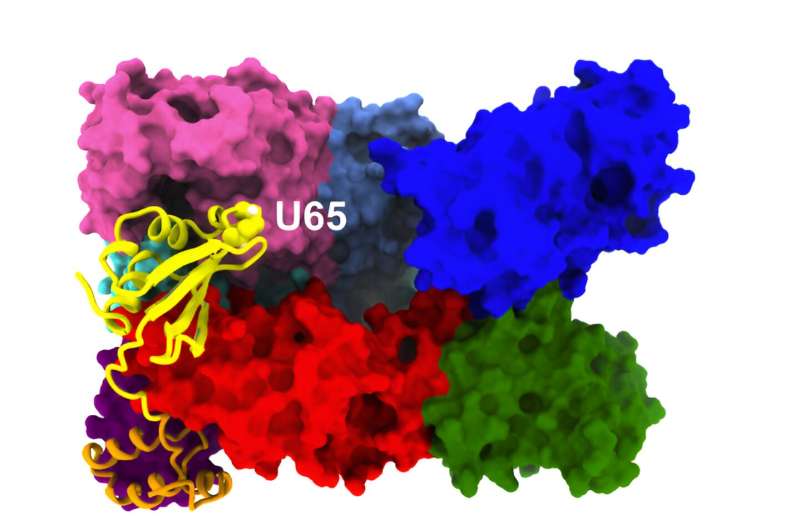Anyone who’s tried to neatly gather a fitted sheet can tell you: folding is hard. Get it wrong with your laundry and the result can be a crumpled, wrinkled mess of fabric, but when folding fails among the approximately 7,000 proteins with an origami-like complexity that regulate essential cellular functions, the result can lead to one of a multitude of serious diseases ranging from emphysema and cystic fibrosis to Alzheimer’s disease.
Fortunately, our bodies have a quality-control system that identifies misfolded proteins and marks them either for additional folding work or destruction, but how, exactly, this quality-control process functions is not entirely known.
Researchers at the University of Massachusetts Amherst have now made a major leap forward in our understanding of how this quality-control system works by discovering the “hot spot” where all the action takes place. The research was recently published in the Proceedings of the National Academy of Sciences.
DNA may be the master blueprint for life, but it is from proteins that we’re built. While many of them are structurally simple, there are approximately 7,000 proteins that must be made in a cell’s secretory pathway and will be either dispersed throughout the cell or secreted to the extracellular space in order to perform their essential functions.
The story begins in the endoplasmic reticulum—the cellular protein factories responsible for correctly building thousands of different proteins—and involves two main players: an enzyme known as UGGT and the partner protein Sep15.
Senior authors Daniel Hebert, professor of biochemistry and molecular biology at UMass Amherst, and Lila Gierasch, distinguished professor of biochemistry and molecular biology and chemistry at UMass Amherst, along with co-author, Kevin Guay, a graduate student in the molecular cellular biology program at UMass Amherst, had shown in previous research that UGGT acts as a “gatekeeper” by reading carbohydrate tags, called N-glycans, embedded into the protein to determine whether or not the protein is correctly folded.
“But there’s something else at work,” says lead-author Rob Williams, a postdoctoral fellow with a joint appointment in both Hebert’s and Gierasch’s labs. “There’s an exclusive club of proteins called ‘selenoproteins,’ which contain the rare element selenium.
“Out of approximately 20,000 different proteins in our bodies, only 25 of them are selenoproteins. The UGGT partner Sep15 is a selenoprotein. Sep15 is always associated with UGGT. But until now, no one knew what it was doing there.”
Using an AI model called AlphaFold2, Williams and his co-authors predicted that the protein Sep15 forms a complex helical shape that looks something like a catcher’s mitt, and that this mitt perfectly matches a complementary site on the UGGT enzyme. The specific site where SEP15 and UGGT bind is also where UGGT reads the N-glycan code that tells it whether or not a protein is correctly folded.

Sep15 perfectly “catches” the correct spot on the enzyme UGGT. © Williams et al.
“Basically,” says Hebert, “we’ve found the hotspot where all the action is taking place—and Sep15 is the key.”
To test their AlphaFold2-generated prediction, the research team designed an experiment using recombinant DNA re-engineering of UGGT to interrupt its binding to Sep15—and, indeed, the modified UGGT failed to form a complex with Sep15.
So what, exactly, is Sep15 doing? “There are two possibilities, both of which we’re following up on,” says Hebert. “Either Sep15 is giving the misfolded protein a chance at correcting its shape, or it is marking that protein for destruction.”
“The complexity of the proteins we are studying allows higher forms of life to function,” says Gierasch, “but the complexity of those proteins also means that they’re more prone to misfolding errors, and misfolding errors can have catastrophic consequences if the quality control process fails.”
Though there is still a great deal of basic research to be done, the team’s research sets the stage for novel drug therapies that target the Sep15/UGGT interface. “This is an untapped pharmaceutical area,” says Hebert, “and Williams’s research has moved us in the right direction for eventual treatment.”
More information:
Hebert, Daniel N. et al, Insights into the interaction between UGGT, the gatekeeper of folding in the ER, and its partner, the selenoprotein SEP15, Proceedings of the National Academy of Sciences (2024). DOI: 10.1073/pnas.2315009121
Provided by
University of Massachusetts Amherst
Citation:
Researchers identify body’s ‘quality control’ regulator for protein folding, could lead to targeted treatments (2024, August 12)



